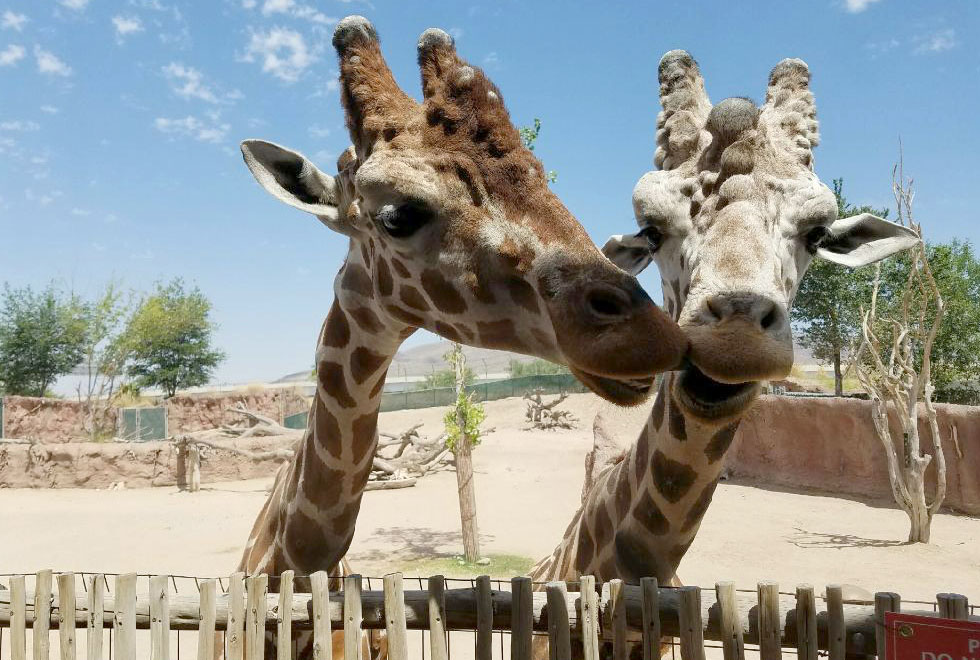What better way to celebrate Earth Month than by anticipating the arrival of a new baby! I’m so excited that the El Paso Zoo and Botanical Gardens announced that Gigi the giraffe is pregnant and due in the next few weeks.
Not only are babies adorable and fun, but they’re also a sign of hope and survival. Especially when the baby is an endangered species.
While we wait for the arrival of Gigi’s baby, let’s explore why this baby is so special and the role that the Species Survival Program plays in modern-day zoos.
Gigi the Giraffe at the El Paso Zoo
As I mentioned, Gigi is executing the arrival of the El Paso Zoo’s first giraffe baby in the coming weeks. The pregnancy was no surprise, though. This has been a years-long effort as the zoo staff works with the Species Survival Plan (SSP) to ensure that Gigi and the father, Juma are safe and happy.
Gigi’s baby will be a welcome addition to the global giraffe population, which has declined by more than 40% in the wild. Their population continues to decline at alarming rates, so every baby giraffe is essential.
What Is the Species Survival Plan at Zoos?
A Species Survival Plan (SSP) is a detailed program designed and implemented by AZA accredited zoos and aquariums to help ensure the long-term survival and health of particular species, especially those threatened or endangered.
The American SSP was developed in 1981 by the Association of Zoos and Aquariums (AZA). SSP programs focus on protecting and aiding animals that are threatened, endangered, or otherwise in danger of extinction in the wild.
What is the goal of SSP?
Species Survival Plans help ensure healthy and genetically diverse animal populations in zoo communities. Accredited zoos, aquariums, and conservation partners participating in SSP programs work together on research, genetics, public education, and even reintroducing animals back into the wild!
Currently, there are about 478 species in the Species Survival Program, and most of them are endangered or threatened.
One of the main components of an SSP is the management of the breeding of animals within captive populations. Zoos accomplish this by keeping records for all the animals in a particular species that currently live in captivity, along with as much information as possible about their genetic makeup and breeding history.
This database helps zookeepers and researchers make recommendations for which animals should breed together to maximize the population’s genetic diversity and reduce the risk of inbreeding.
Not only does this effort keep captive animal populations healthy, it helps conservationists and researchers continue to protect vulnerable wild animal populations.
SSP makes modern zoos different!
The Species Survival Program is just one thing that makes modern zoos very unique. In the past, zoos were designed purely for entertainment purposes. While some education did happen as people saw animals from all over the world, the primary goal was to collect novel animals and house them in captivity.
Modern zoos play a critical role in research, conservation, and education. Zoos no longer house animals in captivity purely for research or entertainment purposes. Each animal at an AZA-accredited zoo is well-cared for and participates in the overall survival of its species.
Since the SSP was developed in the 1980s, coordinated breeding programs within zoos have helped bring dozens of animals back from near extinction. These success stories include the black-footed ferret, the California condor, the golden lion tamarin, the Oregon spotted frog, the red wolf, and the Karner blue butterfly.
Why are modern zoos important?
In addition to efforts like the Species Survival Plan, modern zoos are leading the way in conservation and education efforts.
Most accredited zoos use their revenue for ongoing research and conservation efforts. As I already mentioned, accredited zoos are also critical for species protection and reintroduction efforts.
Zoos serve researchers by offering critical information about wildlife biology, population dynamics, animal behavior, health and welfare, and much more. As zookeepers and scientists study animals in captivity, it guides their conservation efforts with animals living in the wild.
Zoos are also critical for conservation advocacy, which includes public engagement, advocating stewardship, and fundraising for additional conservation efforts.
Education efforts are at the forefront of modern zoo activities. Nearly 50% of the world’s population lives in cities, disconnected from nature. Zoos and aquariums are vital to helping people develop a love of nature and value for conservation.
Gigi’s baby giraffe is an essential addition to the SSP
As we eagerly anticipate the arrival of Gigi’s baby, we won’t just be celebrating one baby giraffe; we look forward to continuing to celebrate the conservation efforts of the Species Survival Plan.
Every healthy baby born through the SSP is critical in protecting that species in captivity and the wild.
A new baby born through the SSP helps researchers better understand the lifecycle of the species. It also helps maintain the genetic diversity of the species.
What can you do?
One fun thing you can do is stay tuned and be prepared to celebrate the arrival of Gigi and Juma’s baby giraffe! Follow us on instagram to stay up to date with news and announcements:
https://www.instagram.com/elpasozoosociety/
If you live near El Paso, plan to visit the zoo after the baby giraffe is born to help welcome the new addition.
If you don’t live near the El Paso Zoo, consider visiting your local AZA-accredited zoo or aquarium this month (April) as part of your Earth Month celebrations. While you’re there, ask a zookeeper what conservation efforts your zoo has and how you might be able to participate.
